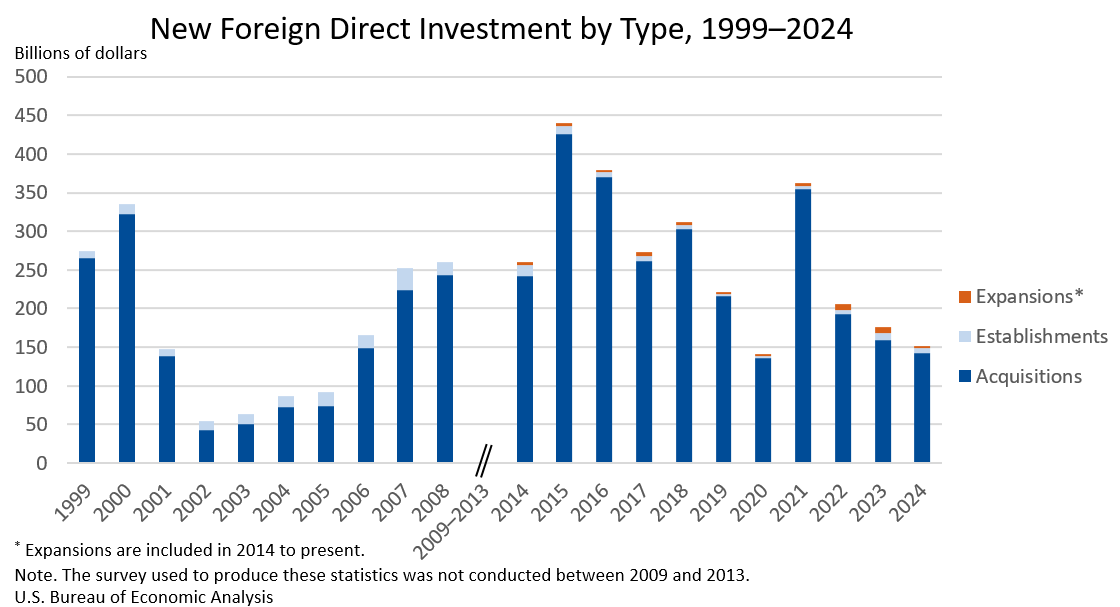Bureau of Economic Analysis
New Foreign Direct Investment in the United States, 2024
Expenditures by foreign direct investors to acquire, establish, or expand U.S. businesses totaled $151.0 billion in 2024, according to preliminary statistics released today by the U.S. Bureau of Economic Analysis. Expenditures decreased $24.9 billion, or 14.2 percent, from $176.0 billion (revised) in 2023 and were below the annual average of $277.2 billion for 2014–2023. As in previous years, acquisitions of existing U.S. businesses accounted for most of the expenditures.
Principal Federal Economic Indicators
Noteworthy
- 2025 News Release Schedule
- Innovation at BEA
- 2025 Annual Updates
- New! Services Trade Data for More Countries
- Data Tool: Trade in Value Added
- Distribution of State Personal Income
- Updated: RIMS II Regional Multipliers
- Arts and Culture
- Space Economy
- FDI Now in State BEARFACTS
- Quick Guide: Price Indexes
The Latest
Personal Income and Outlays, November 2011
Personal income increased $8.5 billion, or 0.1 percent, and disposable personal income (DPI) decreased $5.0 billion, or less than 0.1 percent, in November, according to the Bureau of Economic Analysis.
Gross Domestic Product, 3rd quarter 2011 (third estimate); Corporate Profits, 3rd quarter 2011 (revised estimate)
Real gross domestic product -- the output of goods and services produced by labor and property located in the United States -- increased at an annual rate of 1.8 percent in the third quarter of 2011 (that is, from the second quarter to the third quarter), according to the "third" estimate released by the Bureau of Economic Analysis. In the second quarter, real GDP increased 1.3 percent. The GDP estimate released today is based on more…
Travel and Tourism Satellite Accounts, 3rd quarter 2011
Real spending on travel and tourism decreased at an annual rate of 1.0 percent in the third quarter of 2011 after increasing 3.2 percent (revised) in the second quarter. By comparison, growth in real gross domestic product (GDP) increased 2.0 percent (second estimate) in the third quarter after increasing 1.3 percent in the second quarter. The decrease in real spending on tourism primarily reflected decreases in total transportation and in…
State Quarterly Personal Income, 1st quarter 2010-3rd quarter 2011
WASHINGTON DC, December 19, 2011 - State personal income growth slowed to 0.1 percent, on average, in the third quarter of 2011, according to estimates released today by the U.S. Bureau of Economic Analysis. Growth rates ranged from -0.4 percent in West Virginia to 0.6 percent in Washington State. Personal income fell or was unchanged in twenty states and grew 0.2 percent in the other thirty.
U.S. International Transactions, Third Quarter 2011
U.S. International Transactions: Third Quarter 2011 Current Account
County Estimates of Compensation by Industry, 2008-2010
Compensation increased in 2,480 counties and declined in 633 counties in the U.S. in 2010, as the average annual compensation per job increased 2.7 percent to $58,451, according to statistics released today by the U.S. Bureau of Economic Analysis (BEA).¹ Total compensation of U.S. workers increased 2.2 percent in 2010, as net job losses partially offset compensation growth.
Revised Statistics of Gross Domestic Product by Industry, 2010
Recoveries in durable-goods manufacturing, wholesale trade, and professional, scientific and technical services industries were the leading contributors to the turnaround in U.S. economic growth in 2010, according to revised statistics on the breakout of real gross domestic product (GDP) by industry from the Bureau of Economic Analysis. Overall, 16 of 22 industry groups contributed to real GDP growth.
U.S. International Trade in Goods and Services, October 2011
U.S. Census Bureau U.S. Bureau of Economic Analysis NEWS U.S. Department of Commerce * Washington, DC 20230 U.S. INTERNATIONAL TRADE IN GOODS AND SERVICES October 2011 Goods and Services The U.S. Census Bureau and the U.S.
Personal Income and Outlays, October 2011
Personal income increased $48.1 billion, or 0.4 percent, and disposable personal income (DPI) increased $30.2 billion, or 0.3 percent, inOctober, according to the Bureau of Economic Analysis. Personal consumption expenditures (PCE) increased $8.2 billion, or 0.1 percent. In September, personal income increased $15.5 billion, or 0.1 percent, DPI increased $7.8 billion, or 0.1 percent, and PCE increased $74.5 billion, or 0.7 percent, based on…




